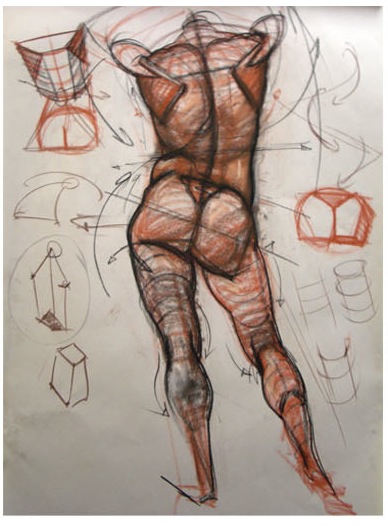Learning how to draw the Human Form efficiently and effectively takes a lot of time, practice and patience. I don’t pretend to be a master of anatomically correct drawing, but I do attempt to consult my charts and references often when I am trying to establish a believable looking figure. Understanding the structure of the human body and its extents and limits is the key in creating forms that are lifelike and realistic in a relative sense – you could be doing life drawings and attempt to be infinitely realistic, or you may be making simplistic cartoons or caricatures which should have some semblance of being anatomically correct.
Though there are subtle differences between individuals, human proportions fit within a fairly standard range, though artists have historically tried to create idealized standards, which have varied considerably over different periods and regions. In modern figure drawing, the basic unit of measurement is the 'head', which is the distance from the top of the head to the chin. This unit of measurement is reasonably standard, and has long been used by artists to establish the proportions of the human figure.
The proportions used in figure drawing are:
An average person, is generally 7-and-a-half heads tall (including the head).An ideal figure, used when aiming for an impression of nobility or grace, is drawn at 8 heads tall.A heroic figure, used in the heroic for the depiction of gods and superheroes, is eight-and-a-half heads tall. Most of the additional length comes from a bigger chest and longer legs.To memorize the ideal measurements and proportions of the male and female human figure should be the student's earnest endeavor, and, with this end in view, the essentials of the various tables that have been constructed for this purpose are presented here.
There are many current and aspiring artists who neglect to refer to the basic fundamentals of anatomy and proportion and dismiss blatant errors as drawing in their own particular style. I’m not going to argue about being right and being wrong in this aspect, but if a body appears jarring and awkward to most people, chances are you’ve done something wrong when you were putting the pieces together. If something isn’t right about a figure that is meant to resemble the human form, (something that you are completely connected to and know and understand) you’ll notice right away. At times – when you draw it yourself, you become so engrossed in your work that you overlook the obvious. To avoid these embarrassing mistakes, make sure you take some time to review the basics of the human form and study the details before leaping into drawing subjects you don’t have a lot of practice with.
Proportions - Male
Note that you’ll want to determine the height of your male on page, divide the height by 8, and work from there – you’ll see there are specific ratios for certain areas of the body. The measurements are determined by head units – one of the 8 divisions you set up is the size of the human head – everything is in relation to that one size.
- The body width = 2 1/3 heads
- The body height = 8 heads
- Distance between nipples on chest = 1 head
- Width of calf muscles together at lower arc = 1 head
- Bottom of the knees = 2 heads from ground level
For further reference, the diagram has a scale in feet to give you an idea of where certain body parts would be in relation to the heights/widths of other objects (vehicles, furniture, etc)
Proportions - Female
For women, the ratios differ slightly as the average form is smaller then the form of an average man. The overall height is measured in 8 Head Units, but because the female head is proportionately smaller, the figure will be smaller.
- The body width = 2 heads wide
- Waist = 1 head wide
- Buttocks = 1 1/2 heads wide
- Width of calf muscles together at mid-point = 1 head wide
- Bottom of the knees = 2 heads from ground level
Now you can alter the proportions slightly to exaggerate features, but you shouldn’t stray too far from the aforementioned guidelines, otherwise your figures will appear alien and awkward. Here’s a diagram with somevariations in human proportion.












No comments:
Post a Comment
Note: Only a member of this blog may post a comment.